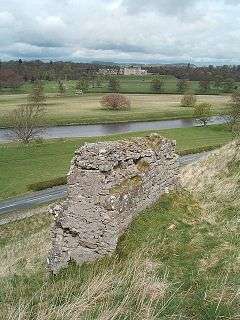Roxburgh Castle


Roxburgh Castle is a ruined royal castle that overlooks the junction of the rivers Tweed and Teviot, in the Borders region of Scotland. Its castleton developed into the royal burgh of Roxburgh, which the Scots destroyed along with the castle after capturing it in 1460. Today the ruins stand in the grounds of Floors Castle, the seat of the Duke of Roxburghe, across the river from Kelso.
History
Tradition states that King David I founded the castle; it is first recorded in c.1128 during his reign. In 1174 it was surrendered to England after the capture of William I at Alnwick, and was often in English hands thereafter. The Scots made many attempts to regain the fortress.[1] On 19 February 1314 it was retaken by Sir James Douglas (the "Black Douglas"), who supposedly disguised his men as cows, but was later lost again.[2] While the Scots had control of the castle, they set about demolishing it, and in the words of the Lanercost Chronicle "all that beautiful castle the Scots pulled down to the ground, like the other castles that they had succeeded in capturing, lest the English should ever again rule the land by holding the castles."[3]
The castle was Edward III of England's base of operations during his 1334 winter campaign against the Scots. A Scottish siege in 1417 necessitated repairs. The Scots again besieged Roxburgh in 1460; in the course of the action metal fragments from the explosion of one of his bombards killed King James II of Scotland. However the Scots stormed Roxburgh, capturing it, and James' queen, Mary of Guelders, had the castle demolished.[1][4]
In 1545, during the Rough Wooing, the English garrison commanded by Ralph Bulmer built a rectangular fort on the site at the instigation of the Earl of Hertford. This was destroyed in 1550 by the terms of the Treaty of Boulogne.[5]
The ruins of Roxburgh Castle stand in the grounds of Floors Castle, the seat of the Duke of Roxburghe.[6] These consist of a large mound, with very little stonework visible.
The 1314 capture of the castle is one of the inspirations of "The Three Perils of Man" by James Hogg.
See also
References
- 1 2 Mike Salter (1985). Discovering Scottish Castles. Shire Publications Ltd. p. 17. ISBN 0-85263-749-7.
- ↑ RCAHMS. "Roxburgh Castle (58412)". Canmore. Retrieved 14 May 2014.
- ↑ Colvin, H. M.; Brown, R. A. (1963), "The Royal Castles 1066–1485", The History of the King's Works. Volume II: The Middle Ages, London: Her Majesty's Stationery Office, p. 819
- ↑ Colvin, H. M.; Brown, R. A. (1963), "The Royal Castles 1066–1485", The History of the King's Works. Volume II: The Middle Ages, London: Her Majesty's Stationery Office, p. 820
- ↑ Mike Salter (1985). Discovering Scottish Castles. Shire Publications Ltd. p. 18. ISBN 0-85263-749-7.
- ↑ Coventry, Martin (2006). The Castles of Scotland. Birlinn. p. 561. ISBN 1-84158-449-5.
External links
- CANMORE/RCAHMS record of Roxburgh Castle; Old Roxburgh Castle; Protector Somerset's Camp
- SCRAN image: Roxburgh Castle
Coordinates: 55°35′47″N 2°27′24″W / 55.59639°N 2.45667°W